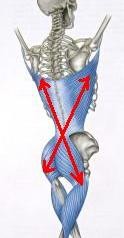To read Part I of this post click here. #6 - IDs weak linksWhat are your top three weak links? Quick don't take time to think. If you had to take some time to think about them then you probably aren't addressing them as much as you should in your program. Worse maybe you couldn't answer this question on the spot and don't know the answer. Worse still what if your opponent knew what your weak links were and exploited them during competition? Or if you became injured by not addressing them? The good news is that you can fix your weak links, even if you're not sure what they are. Any time you perform a unilateral movement pay attention to L-R differences. Are you stronger on one side? Is your balance worse on one side? Do you move better on one side than the other? Figuring out the answers to these will translate more effectively to enhanced performance than the best 'sports-specific' exercise ever will. Make notes in your training journal answering the above questions when you train. Where you are weaker do that side first. Where you don't move as well add in more stretches and mobility drills. And where you have discomfort seek out the best manual therapist you can find. #7 - Additional EST workEST is energy system training and refers to training the various system of the body that provide fuel for our various activities. Cardio tends to be associated solely with aerobic training and therefore we don't use that term unless the duration and intensity justify it. So how does unilateral training lend to EST? Well in a couple of ways. First, by using one limb you trigger muscles that typically don't get a lot of attention when two are used. Secondly the sets tend...
Top 10 Benefits of Unilateral Training
Do you train on one leg? Or with one arm? If so, keep doing so. If not, here are a number of reasons to incorporate single limb, or unilateral training into your program. Top 10 Benefits of Unilateral Training #1 - SafetyFirst and foremost a program must be safe for it to be considered effective. If the risks outweigh the rewards for any exercise chop it from your program and look for another alternative. So why are unilateral lifts considered safer? Well it comes down to the fact that you are using less load. Instead of squatting with 315 lbs on your back for example you might do 225 lbs on one leg. As well, when you consider that many single limb exercises involve DBs, Kbs, cable or something other than a barbell there is less risk of getting trapped under a bar and pinning yourself. This is not to say that unilateral training can't be done with a barbell but it is rare. And in the rare instance you do use a barbell to do a unilateral lift you have the free limb there to spot yourself if needed. #2 - Increased intensityWhen you work with one limb at a time you can handle greater loads and increase the intensity of your training. To see this for yourself test what load you press dumbbells for 5 reps. Maybe you could do 100 lbs for 5 reps. Now rest a few minutes and try again. Only this time press with one arm. You will find you can reach 5 reps no problem and possibly bang out a few more and hit 7 or 8. So what happened? Did you magically become stronger after your first set? No, not really. Instead when all of your focus and attention was able to be...

